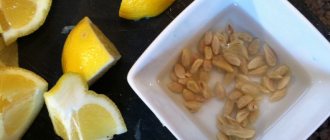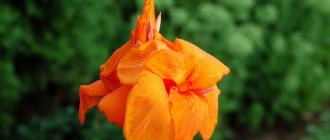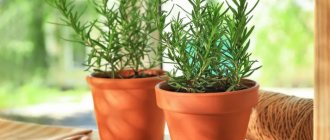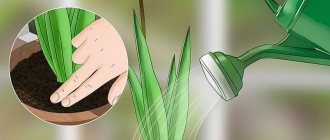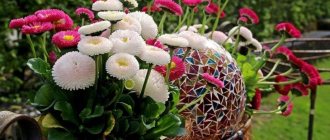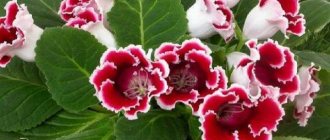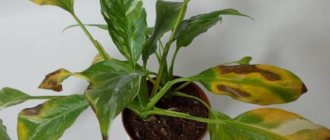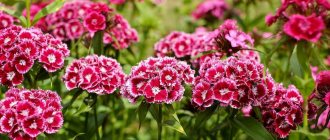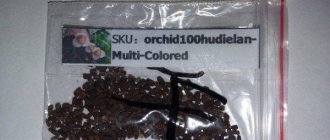Author: Elena N. https://floristics.info/ru/index.php?option=com_contact&view=contact&id=19 Category: Garden plants Published: March 01, 2019Last edits: June 01, 2021
- Pots for seedlings
- Watering
In order for your garden to bloom and smell fragrant from early spring to late autumn, preparations for the beginning of the growing season must begin in winter. Many flowers are propagated by seeds, and in order for them to grow stronger and bloom faster, you need to start growing them before spring, using the seedling method of seed propagation. This is not difficult to do, but you will need special knowledge, which we are ready to share with you.
What indoor plants can you grow yourself from seeds?
You may be interested in: Tomato “rich house”: reviews, photos, yield, variety characteristics
Almost all beautifully flowering houseplants produce seeds, which means they can be grown at home. Seeds of home flowers can be purchased at a specialty store or collected directly from the flower.
What flowers are easy to grow from seeds at home? Many gardeners agree that you can easily grow from seeds: pelargonium (geranium), begonia, orchid, gloxinia, cyclamen, passionflower, abutilon, adenium.
But at home you can grow not only flowering plants, but also flowers with decorative foliage: these are various palm trees (Washingtonia, Hamerops, Howea, Hamedorea), dracaena, Chinese bamboo, coleus, cyperus, bottle tree.
You will be interested in: Tomato Heart of Ashgabat: description of the variety, characteristics, cultivation features, reviews
Various succulents can also be grown from seeds: cactus, agave, aloe, hechtia, bergeranthus, sansevieria, gasteria, haworthia. These plants are considered highly ornamental, and their seeds are very rare.
When plants are grown from seeds, they become more adapted to the conditions in a particular apartment, that is, to light, heat and humidity. That is why those plants that were bought and brought into the house as adults often die due to a sharp change in conditions.
There are other positive aspects to growing indoor plants from seeds, for example, the splitting of decorative features. And, as a consequence, the difference between the grown individuals and the mother. From the seeds of home flowers you can grow unique geraniums, begonias or roses.
Preparing for sowing
Sowing seeds is usually done in shallow containers or pots. On average, the depth of the container should be 6-8 cm, the width will depend on the number of seeds. If the containers are new, there is no need to disinfect them, but if something was previously grown in them, then they need to be thoroughly washed and treated. Treatment can be carried out with a solution of potassium permanganate, or using an alcohol-containing disinfectant spray. You can also wipe with antibacterial wet wipes.
You may be interested: Pecan nut: where does it grow in Russia? Peculiarities of growing nuts in Russia, Moscow region and other climatic conditions
In advance, you need to make several drainage holes at the bottom of the container. In order for the seeds of domestic flowers to germinate better, it is important to provide them with an optimal microclimate; for this, immediately after sowing, the containers must be covered with film or glass. Therefore, when choosing a container for sowing, it is better to think about this in advance.
Fragile and brittle plastic food containers should not be used for sowing, as they quickly collapse under the influence of humidity and stress, and some seeds of perennial house flowers take a very long time to germinate, up to several months.
Let's start with a seed
When sowing seeds, you need to have patience and endurance, since seed germination has different timing. If you use seeds collected from your own plants, then keep in mind that they may generally lose their viability if they do not have time to ripen or are stored incorrectly. In addition, there is always a risk that it will not be possible to obtain a plant with last year’s characteristics, since the selection of seeds also has its own subtleties.
The method of germinating seeds purchased in flower shops is indicated on the bags, which describe in detail the conditions for the successful cultivation of each plant. When purchasing, you need to monitor the expiration date and not buy discounted or expired seeds, otherwise you may not wait for germination at all.
Some plants are capable of very rapid germination, and seedlings can please you within a few days. For example, marigolds, marigolds, petunia, cleome, viola and many others.
Marigold
Cleome
There are also plants with a very long seed germination period, such as brugmansia, lavender, primrose, hellebores, lumbago, and most perennial plants. Various methods are used to stimulate the processes of seed pecking.
Brugmansia
Hellebore
Soil for pets
It is best to germinate seeds in specialized soil for a specific plant. You can buy it at a houseplant seed store. This is the easiest and most reliable option, but there is another option - prepare the soil yourself. To do this, you need to take sand, peat and garden soil in equal proportions. A drainage layer of 2 cm is placed on the bottom of the container. This can be expanded clay, vermiculite, pebbles, sandstone, broken brick. The soil itself is poured on top, which then needs to be well moistened.
If you prepare the soil mixture yourself, it must be disinfected before sowing. You can place the soil in a heat-resistant container and bake it in the oven for 3-4 hours, or pour boiling water over the soil, or treat it with a manganese solution. The finished soil is placed in containers, leaving 2-3 cm to the top edge.
Preparation of seed material
You can purchase already prepared seeds treated with growth stimulants, nutrients and pest protection agents. You can buy them in a specialized store or order seeds of indoor flowers by mail. Such seeds do not require additional preparation. In addition, they should not be soaked.
Planting material collected independently requires special preparation: rejection, sorting, disinfection, stratification, heating, soaking and germination. If the seeds of domestic flowers have a dense shell, then they will need scarification, that is, it must be carefully destroyed.
You may be interested in:Tomato Duckling: description of the variety, characteristics, cultivation features
The preparation of seeds begins in December-January, so that they can be sown in February-March.
Picking
Seedlings are picked 2-4 weeks later, after the second true leaf has developed. It is done as follows:
- Take a seedling with your left hand, and a picking peg with your right;
- The plant is lowered into a hole made with a peg, down to the cotyledons. When picking, the roots of the plant should not bend to the sides or upwards;
- Using a picking peg, press the soil tightly against the roots so that there are no voids left.
After picking, shoots should be protected from drafts and direct sunlight.
Important: When diving, the seedlings are stronger, with a well-developed root system, and the plants flower much earlier. As a rule, picking is resorted to in cases where high-quality, valuable material is used.
When planning to plant seeds and then pick seedlings, the gardener must take into account that the use of this technique requires additional area of closed ground.
If plants are grown without picking, then it is important for the grower not to be late in thinning out the seedlings. In the phase of 2-3 leaves, the weakest plants are removed. The distance between the remaining plants should be at least 1-2 centimeters. After thinning, plants need watering.
Germination
Germinating flower seeds at home begins with soaking. This is especially important after dry heating. You need to pour water at room temperature into a flat container and place the seeds there for 1-3 days.
During soaking, the seed shell swells, and the sprouts hatch much easier and faster. The denser the seeds, the longer they need to be soaked. When soaking, the water needs to be changed after 3-4 hours.
Germinate the seeds of indoor plants in a damp cloth. Here you need to make sure that the fabric does not dry out. Immediately after the seeds hatch, they can be sown. There is no need to wait until the sprouts in the fabric grow large - they can get tangled and break off.
Sowing seeds
When planting seeds, the sowing depth is very important - the germination of the seeds depends on it. The sowing depth will depend on the size of the seeds themselves. If the seeds are more than 2 mm in diameter, then to calculate the sowing depth you need to multiply the diameter of the seed by two. At the same time, if the soil is heavy, then the depth can be slightly reduced, and if the soil is light, the depth can be increased slightly.
Small seeds, up to 2 mm in diameter, do not need to be covered with soil at all. On the contrary, some plants germinate in the light, such as pelargoniums and petunias.
Very small seeds of indoor flowers are mixed with sand for sowing. You can also mix such seeds with a lighthouse crop, for example, radishes. Radishes sprout in 4-5 days and will clearly define rows of flowers. When the flowers begin to sprout, the radishes need to be removed from the rows.
Annuals: When to Plant Annual Flower Seeds in Open Ground
Annual flowers have another very important indicator, such as their tolerance to cold...
- Frost-resistant flowers can be planted as soon as the soil is thawed enough to be dug in and the soil temperature does not drop below -4°C.
- Medium-hardy flower seeds can be planted no earlier than the ground has warmed up enough; they can withstand light frost and will most likely be fine.
- Heat-loving plants should not be planted until the danger of frost has completely passed. Any temperature below 4 C will result in plant death.
See our Flower Planting Guide for a breakdown of each flower's hardiness level.
If you want to have your warm- and medium-hardy annual flowers in the garden as early as possible, then you need to sow them indoors (discussed further at the bottom of the page) and transplant them into the garden when the air temperature is more favorable.
If you want to learn how to plant flower seeds (annual or perennial) outdoors, check out our next section...
Picking flower seedlings
Indoor plants sprout in different ways, usually from 7 days to 1 month. When the plant has true leaves (1-3), the seedlings need to be pruned.
It is better to immediately plant indoor flowers in separate containers or pots. After transplantation, the plants will begin to get stronger and grow faster. If the growth of the plant stops, and the plant itself withers with proper care, then it is better to throw it away.
Individual containers are selected for each plant in such a way that the roots feel free, and there is still 3-4 cm of free space from the edges of the container.
There is also no need to take a container that is too large, since moisture can stagnate in it and the roots can rot. Prepare and fill the container with soil in the same way as when sowing seeds.
Aftercare
After transplanting the plants into individual containers, the wait for the first flowering begins. Perennial flowers grown from seeds bloom later than those propagated vegetatively. Sometimes you will have to wait 3-4 years for the first flowering.
In the first year of growing the plant, you need to water it regularly, loosen the soil and feed it at least twice. At the beginning of summer, flowers need to be fed with humate-based fertilizer, and by winter potassium fertilizers will be required. Intermediate fertilizing can be carried out with special fertilizers for a specific type of plant.
By winter, watering is reduced and the amount of sunlight is reduced. With the onset of spring, plants will need more light; a special lamp will help provide additional lighting. Today you can buy a specialized phytolamp with red-blue light to further stimulate plant growth. Nfre. The phytolamp needs to be turned on for only 1-2 hours a day. In summer, flowers can be placed on a balcony or loggia for air and sunbathing.
Perennials are a necessary element of the garden
Perennials
The difference between them and annuals is their lifespan; once you plant a perennial, you can be sure that for many years, if you take proper care and apply the necessary fertilizing, you will be provided with flowering. However, in areas with harsh winters, you need to carefully choose plants taking into account their winter hardiness, since there is a threat of freezing or damping off. Another weakness of perennial flowering plants is their rapid flowering period. For most of their growing season, perennials build up green mass, then a short flowering occurs, and the plant begins to prepare for winter. Therefore, despite all the beauty and charm of perennial flowers, after flowering they can lose their decorative effect and need to be supplemented with annual flowers.
Several plants you can grow at home from seeds
- Adenium is a prominent representative of the Kutrov family. This succulent has a strong trunk and grows up to 50 cm at home. By creating favorable conditions for the adenium seeds, they will sprout well. To create the necessary conditions, you need to constantly warm up the sown seeds. The temperature of the soil with seeds should be around 25-29 degrees. Adenium seeds are delicate brownish in color and look like small straws. This indoor flower will delight gardeners with its rapid growth.
- Plumeria. Plumeria is a tropical plant distinguished by its amazing beauty and pleasant aroma. You can grow plumeria at home from seeds only if you plant the seeds correctly and then properly care for the plant. Plumeria grows quite tall; at home it can reach 2 meters. This plant is best grown in winter gardens and greenhouses. Plumeria seeds germinate well under the same conditions as adenium seeds.
- Date fruit. It is easy to grow dates at home from their own seeds. But here you need to remember that you cannot expect fruit from such a plant. The date is a large palm, but it grows well both at home and in an office or greenhouse. Date seeds germinate quickly; the first shoots can appear within a week.
- Passionflower. Passionflower is a vine that is also easy to grow at home. To grow passionflower from seeds, you need to properly prepare the soil: mix peat, humus and leaf soil, bake this mixture in the oven for 10 minutes and let it cool. It is also important that the seeds are fresh - the germination rate will be higher.
- Pelargonium. Pelargonium is a perennial flower of the geranium family. Even a beginner can grow this plant, observing the basic requirements for sowing and subsequent care. Seeds for sowing can be easily purchased at a regular garden store, and you can choose varietal pelargonium.
Growing indoor plants from seeds is a very interesting activity, especially since seeds are freely available today. You can easily buy them in a store or order seeds of indoor flowers by mail. The cultivation itself may be a bit of a hassle, but experimenting with new plants is a lot of fun.
Source
Good lighting
Most of the annual flowers we grow come from tropical countries where daylight hours are 14 hours or more. On short winter days, seedlings need additional lighting with fluorescent lamps or special phytolamps in order to obtain high-quality seedlings.
Otherwise, the plantings will be pale, stretch out, the stem will become thin and the plant may get sick. The lamp is placed close to the crop (25-30 cm), the lamp is used at dusk for at least 6 hours, or, if more convenient, for three hours early in the morning and in the evening. The seedlings will immediately get stronger.
